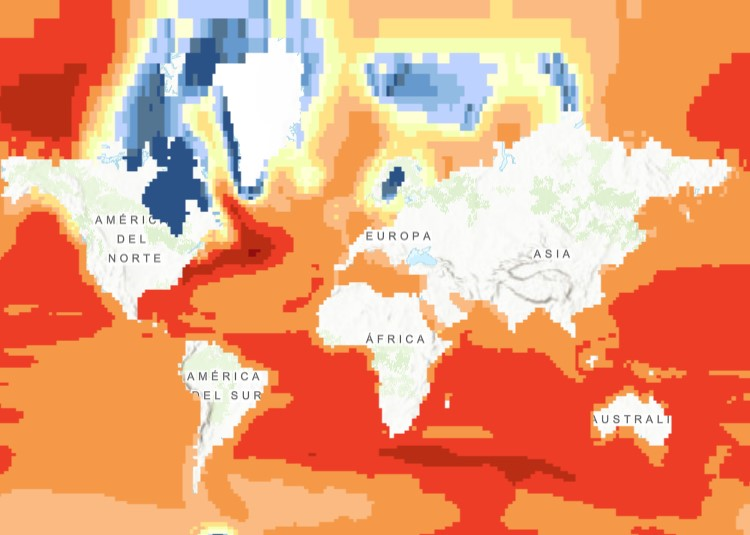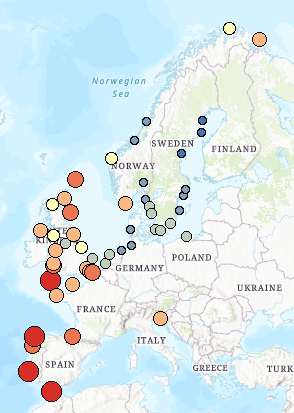CLIMATE-ADAPT
Type of resources
Available actions
Topics
INSPIRE themes
Keywords
Contact for the resource
Provided by
Years
Formats
Representation types
Update frequencies
Scale
Resolution
-

This vector dataset presents the extent of areas in European countries directly affected by wildfires (period 2000-2017). This dataset can be used as one of the indications where the danger of wildfires may persist or increase in the future under the changing climate. The dataset is one of the output of the “European Forest Fire Information System-EFFIS” (http://effis.jrc.ec.europa.eu) provided by the Joint Research Centre (JRC). The dataset is also part of the EEA indicator "Forest fires": https://www.eea.europa.eu/data-and-maps/indicators/forest-fire-danger-2/assessment.
-

The raster dataset (1ºx1º) shows the projected change in relative sea level (in metres) in 2081-2100 compared to 1986-2005 for the medium-low emission scenario RCP4.5, based on an ensemble of Coupled Model Intercomparison Project Phase 5 (CMIP5) climate models. Projections consider land movement due to glacial isostatic adjustment but not land subsidence due to human activities. No projections are available for the Black Sea. The dataset has been used as a source for an earlier version of the EEA indicator “Global and European Sea Level”: https://www.eea.europa.eu/data-and-maps/indicators/sea-level-rise-5/assessment.
-

The gridded dataset presents the forest fire danger in Europe for projected climate conditions under the Representative Concentration Pathways (RCP) 4.5 scenario for the temporal range 2071-2100. The forest fire danger is expressed by the average Seasonal Severity Rating index (derived from the Canadian Fire Weather Index System), provided by the Joint Research Centre. The SSR series was computed usign the GCM-RCM run KNMI-RACMO2-ECHAM5 of ENSEMBLES project. Average 2071-2100 SSR levels are provided in the dataset. The dataset contributes to an earlier version of the EEA indicator "Forest fires": https://www.eea.europa.eu/data-and-maps/indicators/forest-fire-danger-2/assessment.
-

This dataset represents the observed trend in maximum annual five day consecutive precipitation over Europe, between 1960 and 2015, during the winter season (December, January, February). Heavy precipitation events have become more intense and more frequent in Europe on average, but there are important differences across regions, seasons, time periods, heavy precipitation indices and underlying datasets. Studies generally agree that heavy precipitation has become more intense in northern and north-eastern Europe since the 1950s, even though not all changes are statistically significant. Different studies and indices show diverging trends for south-western and southern Europe. Heavy precipitation may lead to local surface water flooding in cities, therefore should be considered in adaptation planning. This dataset is used also in the EEA Indicator "Heavy precipitation in Europe": https://www.eea.europa.eu/data-and-maps/indicators/precipitation-extremes-in-europe-3/assessment, which in the meantime has been updated.
-

The raster dataset (grid 0.25° x 0.25°) presents the trends in frequency of meteorological droughts between 1950 and 2012. Trends are based on a combination of three different drought indices - SPI (Standard Precipitation Index), SPEI (Standardized Preciptation Evapotranspiration Index) and RDI (Reconnaisance Drought Index) accumulated over 12-month periods. The dataset contributes to an earlier version of the EEA indicator "Meteorological and hydrological droughts": https://www.eea.europa.eu/data-and-maps/indicators/river-flow-drought-2/assessment
-

This gridded dataset presents the projected changes (in percentage) in heavy precipitation in winter season (December, January, February) in Europe, from 1971-2000 to 2071–2100 for the Representative Concentration Pathways (RCP) 8.5 scenario, based on the ensemble mean of different Regional Climate Models (RCMs) nested in different General Circulation Models (GCMs). This dataset is an output of the EURO-CORDEX data, produced in the context of the EURO-CORDEX initiative. EURO-CORDEX is the European branch of the CORDEX initiative, producing ensemble climate simulations based on multiple dynamical and empirical-statistical downscaling models forced by multiple global climate models from the Coupled Model Intercomparison Project Phase 5 (CMIP5). More information about this initiative on: https://www.euro-cordex.net/060374/index.php.en. The dataset has been used in the EEA Indicator "Heavy precipitation in Europe": https://www.eea.europa.eu/data-and-maps/indicators/precipitation-extremes-in-europe-3/assessment, which in the meantime has been updated.
-

This gridded dataset represents the observed trend in maximum annual five day consecutive precipitation over Europe, between 1960 and 2015, during summer (June, July, August). Heavy precipitation events have become more intense and more frequent in Europe on average, but there are important differences across regions, seasons, time periods, heavy precipitation indices and underlying datasets. Studies generally agree that heavy precipitation has become more intense in northern and north-eastern Europe since the 1950s, even though not all changes are statistically significant. Different studies and indices show diverging trends for south-western and southern Europe. Heavy precipitation may lead to local surface water flooding in cities, therefore should be considered in adaptation planning. This dataset is used also in the EEA Indicator "Heavy precipitation in Europe": https://www.eea.europa.eu/data-and-maps/indicators/precipitation-extremes-in-europe-3/assessment, which in the meantime has been updated.
-

The vector dataset presents the percentage of green space in densely built-up areas for a series of individual European cities (included in Urban Audit) for the year 2012. The presence and proportion of green space in densely built-up urban areas is an important aspect of adaptation to climate change. Green space regulates the microclimate of the city, reducing the temperatures. It also reduces the risk of flooding related to heavy precipitation, as vegetation and permeable surfaces retain and infiltrate rainwater, reducing the amount that comes into the drainage system. Data on green space was obtained from Copernicus Urban Atlas 2012, extracting the Urban Atlas classes treated as green space. The Urban Morphological Area (UMZ) dataset for 2012 and the Eurostat Urban Audit dataset (polygon, 2011-2014) were been used to calculate the total area within the core city. The values were then allocated to the city centroids from the same Eurostat Urban Audit dataset.
-

This dataset presents the estimated multiplication factor by which the frequency of flooding events of a given height in European tide gauges will change between 2010 and 2100, due to projected regional sea relative level rise under the Representative Concentration Pathways (RCP) 4.5 scenario. Values larger than 1 indicate an increase in flooding frequency. This dataset is derived from the Figure 13.25(b) of the Working Group I contribution to the IPCC Fifth Assessment Report (http://www.climatechange2013.org/images/report/WG1AR5_ALL_FINAL.pdf). This dataset also contributes to an earlier version of the EEA Indicator "Global and European sea-level": https://www.eea.europa.eu/data-and-maps/indicators/sea-level-rise-5/assessment.
-

The raster dataset presents the median of the projected number of extreme heatwaves in the near future (2020–2052) in Europe, following the Representative Concentration Pathways (RCP) 8.5 scenario. The dataset is one of the multimodel ensemble used to project future occurrence and severity of heat waves under different RCP, which were adopted by the Intergovernmental Panel on Climate Change for its Fifth Assessment Report (AR5). The dataset is one of the output of the JRC “Number of heat waves” data described here: https://agupubs.onlinelibrary.wiley.com/doi/epdf/10.1002/2014JD022098. The dataset has been used as a source for the EEA indicator “Global and European temperature”: https://www.eea.europa.eu/data-and-maps/indicators/global-and-european-temperature-8/assessment, which in the meantime has been already updated.
 RUC Geo-Data catalogue
RUC Geo-Data catalogue